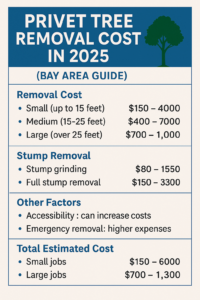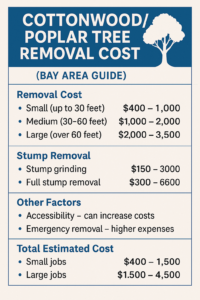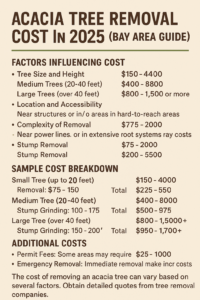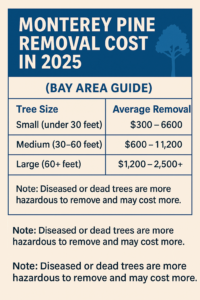Picture this: You’re finally ready to renovate your San Bruno backyard when you discovered the majestic oak tree blocking the addition plans wasn’t just any tree—it was a protected Heritage Tree under the city’s strict ordinances. What seemed like a straightforward landscaping decision suddenly became a complex regulatory maze involving certified arborist reports, permit applications, and potential fees totaling over $750.
If this scenario sounds familiar, you’re not alone. Many San Bruno property owners find themselves navigating the city’s comprehensive tree protection laws without realizing the specific requirements for native species like Bay, Buckeye, Oak, Redwood, and Pine trees. Whether it’s a 6-inch diameter Heritage Tree or any tree exceeding 10 inches at chest height, understanding these regulations can save homeowners thousands in fines and project delays.
This comprehensive guide will walk readers through San Bruno’s tree protection ordinances, explain the permit process step-by-step, and provide practical insights for property owners, developers, and landscaping professionals dealing with protected trees in their projects.
Understanding San Bruno’s Tree Removal Regulations
San Bruno’s Tree Protection Framework
San Bruno’s Heritage Tree Ordinance establishes comprehensive protection for the city’s urban forest, reflecting decades of environmental stewardship that began in response to rapid development pressures during the 1980s. This framework has evolved to become one of the Peninsula’s most structured tree preservation systems.
The ordinance defines heritage trees as native species including California Bay, California Buckeye, Oak, Redwood, and Monterey Pine with diameters of 6+ inches measured at 54 inches above natural grade. Additionally, all trees regardless of species with 10+ inch diameters at the same height qualify for protection.
Current Permit Structure
Permit fees reflect the city’s commitment to tree preservation:
- Pruning permits: $85
- Removal permits: $171
- Tree replacement fee: $598
According to the city ordinance, “All permit applications must include a certified arborist report, accurate diameter measurements, detailed cost estimates, and current photographs of the subject tree.” The Community Services Department processes these applications, with permits remaining valid for six months and possible extensions available.
Regional Comparison
San Bruno’s regulations are notably more comprehensive than many neighboring Peninsula cities. While Millbrae and South San Francisco focus primarily on street trees, San Bruno’s ordinance extends protection to private property trees, creating a more robust urban canopy preservation system.
Property owners must navigate this framework when planning construction or landscape modifications. The certified arborist requirement ensures professional assessment of tree health and removal necessity, while the substantial replacement fee encourages preservation over removal.
This regulatory structure balances development needs with environmental protection, positioning San Bruno as a regional leader in urban forestry management.
Protected Trees and Permit Requirements
San Bruno protects specific tree species and sizes requiring permits before removal or significant pruning. Understanding these regulations helps property owners comply with municipal requirements.
Protected Species and Size Requirements
- Native species protected at 6+ inches diameter:
- Bay trees
- Buckeye trees
- Oak trees
- Redwood trees
- Pine trees
- All tree species protected at 10+ inches diameter (measured at 54 inches above ground level)
Permit Application Process
- Hire a certified arborist to assess the tree and prepare a detailed report explaining the necessity for removal or pruning
- Measure tree diameter at exactly 54 inches above ground level
- Obtain cost estimates from qualified tree service professionals for the proposed work
- Take current photographs of the tree showing its condition and location
- Submit complete application to the Community Services Department with all required documentation
- Heritage trees require separate permits even when part of larger construction projects
Processing Timeframes and Extensions
| Permit Aspect | Timeframe |
|---|---|
| Permit Validity | 6 months |
| Extension Process | Director authorization required |
| Extension Duration | Case-by-case basis |
Next Steps
Property owners should contact the Community Services Department directly for guidance on specific tree situations, permit applications, or questions about protected species identification. Early consultation prevents delays and ensures compliance with San Bruno’s tree protection ordinances.
Professional Tree Removal Services in San Bruno
Selecting Qualified Local Professionals
San Bruno homeowners face unique challenges when selecting tree service providers due to the area’s specific terrain and climate conditions. With over 1,300 BBB-listed tree service providers in the greater Bay Area, choosing the right professional requires careful consideration.
Local Professional Examples:
- Firefighter Tree Service
- Imperial Tree Removal Service
- Precision Tree Care
- EC Tree Service
- Kielty Arborists Services LLC
Essential Qualifications Checklist: □ ISA (International Society of Arboriculture) certification □ Current liability and workers’ compensation insurance □ Local business license and permits □ Minimum 5 years San Bruno area experience □ References from recent local projects □ Equipment properly maintained and inspected
Real-World Impact Story: Last year, a San Bruno property owner hired an uncertified contractor to remove a large oak tree. The improper cutting technique caused the tree to fall onto neighboring property, damaging a fence and garden. The homeowner faced thousands in liability costs that proper insurance from a certified professional would have covered.
Case Study: Professional vs. Amateur Approach When comparing two recent tree removals on adjacent Portola Drive properties, the difference was striking. The certified arborist used proper rigging techniques, protecting surrounding landscaping and structures. The uncertified contractor’s work resulted in damage to the neighbor’s driveway and irrigation system, costing $3,200 in repairs.
Qualified professionals understand San Bruno’s hillside terrain, wind patterns, and soil conditions. They provide permit assistance for protected species and offer comprehensive services including emergency storm response, disease management, and soil treatments. Their expertise ensures safe, compliant work that protects both property values and neighborhood relationships.
Cost Factors and Getting Quotes
Tree removal expenses in San Bruno depend on several key variables that property owners should understand before proceeding with any project.
Factors Affecting Removal Costs
- Tree size and species – Larger trees require specialized equipment and more labor hours
- Location accessibility – Trees near structures or power lines increase complexity
- Terrain challenges – San Bruno’s steep slopes require additional safety measures
- Permit requirements – City fees add $85 for pruning, $171 for removal, or $598 for replacement
San Bruno’s Unique Pricing Challenges
The city’s hilly terrain and dense urban environment significantly impact removal costs. Properties on steep slopes require specialized equipment and additional crew members for safety, often increasing base prices by 25-40%. Urban density means contractors must navigate narrow streets and limited parking, potentially requiring traffic control permits and extended work schedules.
Getting Multiple Quotes
Property owners should obtain at least three detailed quotes comparing:
- Labor costs and crew size
- Equipment rental fees
- Permit application assistance
- Debris removal and disposal
- Stump grinding services
Professional vs. DIY Considerations
While homeowners might consider DIY approaches to save money, professional services provide crucial value through permit compliance expertise and proper safety protocols. Incorrect permit applications can result in fines exceeding $1,000, while insurance claims from DIY accidents often face denial. Professional arborists understand San Bruno’s specific requirements, ensuring projects meet city standards while protecting property values and neighborhood aesthetics.
Investment in qualified professionals typically proves cost-effective when considering permit navigation, safety risks, and potential penalties.
Environmental and Safety Considerations
San Bruno’s Unique Ecosystem
San Bruno’s distinctive landscape showcases a remarkable tapestry of native species that form the backbone of the local ecosystem. Majestic Bay trees stretch their aromatic canopies across the hillsides, while California Buckeyes display their striking white flower clusters in spring. Ancient Oaks provide crucial acorn harvests for wildlife, and towering Redwoods create cathedral-like groves that shelter countless species. Native Pine trees anchor the steeper slopes with their extensive root systems, creating a natural network of soil stabilization.
These diverse tree species serve as essential wildlife corridors, providing nesting sites for migratory birds, shelter for native mammals, and food sources for local fauna. The environmental impact of removing even a single mature tree can ripple through the ecosystem, affecting everything from soil microorganisms to larger predators. San Bruno’s tree replacement requirements recognize this interconnectedness, mandating strategic replanting to maintain the urban canopy’s ecological benefits.
The theoretical framework of soil stability becomes particularly critical in San Bruno’s hilly terrain. Tree removal disrupts established root systems that have spent decades binding soil particles together, potentially triggering erosion cascades during winter rains. When roots decompose after tree removal, they leave behind channels that can become conduits for water infiltration and soil movement.
Environmental stewardship in tree removal decisions requires balancing development needs with ecosystem preservation, ensuring that San Bruno’s unique natural heritage continues to thrive for future generations while maintaining the geological stability that protects both property and wildlife habitats.
Special Circumstances and Emergency Situations
San Bruno property owners face unique challenges when trees pose immediate safety threats. Understanding emergency permit procedures ensures swift action while maintaining compliance with local regulations.
Hazardous Tree Definitions
The city defines hazardous trees as those presenting “imminent danger to persons or property.” Emergency permits apply when trees threaten structures, power lines, or public safety due to disease, storm damage, or structural instability.
Standard vs. Emergency Processes
Standard permits require a certified arborist report, cost estimates, diameter measurements, and photographs—a process typically taking several days. Emergency situations allow expedited review through the Community Services Department, often processed within 24 hours when immediate danger exists.
City regulations specify that emergency documentation must include “photographic evidence of the hazardous condition and professional assessment of imminent risk factors.”
Emergency Scenarios
Common situations warranting emergency permits include:
- Trees leaning against homes after storms
- Large branches hanging over occupied areas
- Root system failure threatening foundations
- Disease-weakened trees near walkways
Action Steps
For immediate emergencies: Contact San Bruno emergency services at 911 if trees threaten life or property.
For urgent but non-life-threatening situations: Call the Community Services Department directly at (650) 616-7058 during business hours.
For development projects: Property developers should coordinate with city planners before tree removal to ensure compliance with construction timelines.
Property owners should document hazardous conditions with photos and obtain professional arborist assessments to support emergency permit applications. Quick action protects both safety and legal compliance.
Compliance and Post-Removal Requirements
Property owners in San Bruno must follow specific procedures after tree removal to maintain compliance with city regulations.
Tree Replacement Procedures:
- Contact the Community Services Department within 30 days of removal
- Pay the $598 replacement fee per tree removed
- Select species from the city’s approved list suitable for San Bruno’s Mediterranean climate
- Plant replacements within the designated timeframe
- Ensure proper spacing and location according to city guidelines
Penalty Structure: Property owners who remove trees without permits face double replacement requirements. This means removing one tree without authorization requires planting and paying fees for two replacement trees, significantly increasing costs and compliance obligations.
City Monitoring: San Bruno officials conduct regular inspections to verify compliance. They monitor replacement plantings for survival rates, proper species selection, and adherence to planting specifications. Property owners receive follow-up visits to ensure trees establish successfully.
Species Selection: Choose drought-tolerant, native or climate-appropriate species that thrive in San Bruno’s conditions. The Community Services Department provides comprehensive approved species lists tailored to different property types and locations.
Take Action: Property owners should consult with the Community Services Department before removal and work with certified arborists for proper compliance. Early consultation prevents violations and ensures smooth replacement processes while maintaining San Bruno’s urban forest canopy.
Conclusion
Successfully navigating San Bruno’s tree protection ordinance requires understanding local regulations and working with qualified professionals. Property owners must obtain permits for heritage trees and protected species, ensuring compliance with municipal requirements. Certified arborists provide essential expertise in proper procedures and documentation, protecting homeowners from potential violations.
Environmental considerations extend beyond legal compliance. Trees contribute significantly to ecosystem health, soil stability, and community well-being. Professional tree services ensure these environmental benefits are preserved while meeting property management needs.
San Bruno’s Community Services Department stands ready to provide guidance for specific situations. Whether planning construction projects, addressing tree health concerns, or managing landscape changes, residents benefit from clear communication with city officials.
Taking proactive steps to understand regulations, consulting certified professionals, and considering environmental impacts creates successful outcomes for all stakeholders. Property owners who embrace these practices contribute to San Bruno’s sustainable urban forest while protecting their investments. For questions about specific trees or projects, contacting the Community Services Department ensures proper guidance and compliance with local ordinances.






